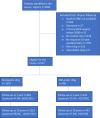Obesity as an independent risk factor for poor long-term outcome after mid-urethral sling surgery
- PMID: 38863323
- PMCID: PMC11266627
- DOI: 10.1111/aogs.14883
Obesity as an independent risk factor for poor long-term outcome after mid-urethral sling surgery
Abstract
Introduction: High body mass index (BMI) is a risk-factor for stress urinary incontinence (SUI). Mid-urethral sling (MUS) surgery is an effective treatment of SUI. The aim of this study was to investigate if there is an association between BMI at time of MUS-surgery and the long-term outcome at 10 years.
Material and methods: Women who went through MUS surgery in Sweden between 2006 and 2010 and had been registered in the Swedish National Quality Register of Gynecological Surgery were invited to participate in the 10-year follow-up. A questionnaire was sent out asking if they were currently suffering from SUI or not and their rated satisfaction, as well as current BMI. SUI at 10 years was correlated to BMI at the time of surgery. SUI at 1 year was assessed by the postoperative questionnaire sent out by the registry. The primary aim of the study was to investigate if there is an association between BMI at surgery and the long-term outcome, subjective SUI at 10 years after MUS surgery. Our secondary aims were to assess whether BMI at surgery is associated with subjective SUI at 1-year follow-up and satisfaction at 10-year follow-up.
Results: The subjective cure rate after 10 years was reported by 2108 out of 2157 women. Higher BMI at the time of surgery turned out to be a risk factor for SUI at long-term follow-up. Women with BMI <25 reported subjective SUI in 30%, those with BMI 25-<30 in 40%, those with BMI 30-<35 in 47% and those with BMI ≥35 in 59% (p < 0.001). Furthermore, subjective SUI at 1 year was reported higher by women with BMI ≥30, than among women with BMI <30 (33% vs. 20%, p < 0.001). Satisfaction at 10-year follow-up was 82% among women with BMI <30 vs 63% if BMI ≥30 (p < 0.001).
Conclusions: We found that higher BMI at the time of MUS surgery is a risk factor for short- and long-term failure compared to normal BMI.
Keywords: body mass index; long‐term effect; mid‐urethral sling; obesity; overweight; stress urinary incontinence.
© 2024 The Author(s). Acta Obstetricia et Gynecologica Scandinavica published by John Wiley & Sons Ltd on behalf of Nordic Federation of Societies of Obstetrics and Gynecology (NFOG).
Conflict of interest statement
None.
Figures




Similar articles
-
Childbirth after mid-urethral sling surgery: effects on long-term success and complications.Int Urogynecol J. 2020 Mar;31(3):485-492. doi: 10.1007/s00192-019-04067-9. Epub 2019 Aug 13. Int Urogynecol J. 2020. PMID: 31410519
-
Midterm postoperative results of mid-urethral slings. Role of ultrasound in explaining surgical failures.Neurourol Urodyn. 2022 Nov;41(8):1834-1843. doi: 10.1002/nau.25032. Epub 2022 Sep 4. Neurourol Urodyn. 2022. PMID: 36057980
-
Comparing risk of repeat surgery for stress urinary incontinence after mid-urethral slings and polyacrylamide hydrogel.Acta Obstet Gynecol Scand. 2021 Dec;100(12):2186-2192. doi: 10.1111/aogs.14271. Epub 2021 Oct 8. Acta Obstet Gynecol Scand. 2021. PMID: 34622944
-
Does body mass index influence the outcome of midurethral sling procedures for stress urinary incontinence?Int Urogynecol J. 2017 Jun;28(6):817-822. doi: 10.1007/s00192-016-3181-7. Epub 2016 Nov 7. Int Urogynecol J. 2017. PMID: 27822886 Review.
-
Sexual Functions in Women With Stress Urinary Incontinence After Mid-Urethral Sling Surgery: A Systematic Review and Meta-Analysis of Prospective Randomized and Non-Randomized Studies.J Sex Med. 2020 Oct;17(10):1956-1970. doi: 10.1016/j.jsxm.2020.07.003. Epub 2020 Jul 30. J Sex Med. 2020. PMID: 32741744
Cited by
-
Author Reply.BJOG. 2025 Mar;132(4):541-542. doi: 10.1111/1471-0528.18013. Epub 2024 Nov 25. BJOG. 2025. PMID: 39582421 Free PMC article. No abstract available.
References
-
- Hannestad YS, Rortveit G, Daltveit AK, Hunskaar S. Are smoking and other lifestyle factors associated with female urinary incontinence? The Norwegian EPINCONT Study. BJOG. 2003;110:247‐254. - PubMed
-
- Statistik om övervikt och fetma hos vuxna. Accessed January 2024. www.folkhalsomyndigheten.se2023.
-
- State of Obesity 2023: Better Policies for Healthier America – TFAH. Trust for America's Health. Accessed January 2024. https://www.tfah.org.
-
- Doumouchtsis SK, Loganathan J, Pergialiotis V. The role of obesity on urinary incontinence and anal incontinence in women: a review. BJOG. 2022;129:162‐170. - PubMed
-
- Fuselier A, Hanberry J, Margaret Lovin J, Gomelsky A. Obesity and stress urinary incontinence: impact on pathophysiology and treatment. Curr Urol Rep. 2018;19:10. - PubMed
MeSH terms
Grants and funding
LinkOut - more resources
Full Text Sources
Medical

